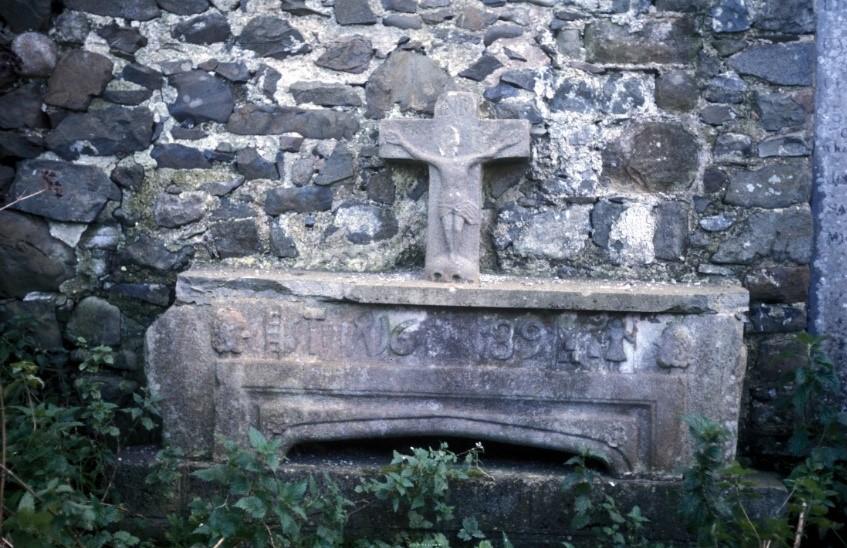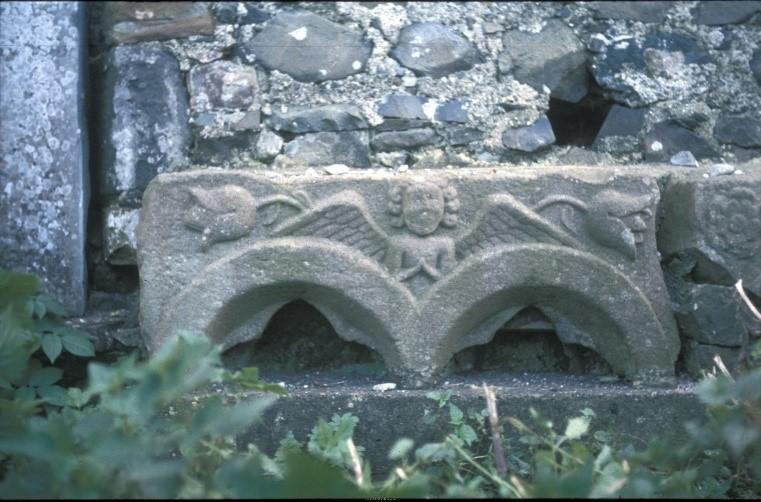The Church of the Beekeeper

Local tradition has it that Bremore was the first place in Ireland where beekeeping was practiced. It was said to have been introduced there by St. Molaga who:
settled for a short time at Bremore close to Balbriggan and Balrothery. There he kept a swarm of Bees, [a] portion of those brought over from Wales by St Modomhnac. From this circumstance his church was called Lannbeachra (The Church of the Bee Man) and the ruins of it may still be seen close to a farmhouse in Bremore
(SC Vol. 0784: 17)
St. Molaga is credited with founding an early church called Lann Beachaire on lands granted to him by a local chieftain whom he had cured of ulcers (SC Vol. 0783: 385; SC Vol. 0783: 385). While no evidence of this early structure has so far been found the legacy of St. Molaga is preserved in both the name of the ‘Lambeecher’ housing estate in Balbriggan and in a ruined late medieval church and graveyard dedicated to the saint in Bremore (DU00029; DU00028). This ruined church and graveyard along with an adjacent restored fortified house make up the Bremore castle complex.
Most of the information we have for Molaga comes from a 14th century manuscript called the Book of Fermoy which was commissioned by the Roche family who ruled parts of County Cork. This text contains poetry and prose relating to the Roche family as well as accounts of the lives of various saints including St. Molaga. The folklore agrees with the Book of Fermoy in that it connects Molaga to places within Cork such as Killdorrey, Labmolaga, Fermoy and Kilruddery (SC Vol. 0783: 206; 341). However, Molaga has also been connected to Wales through his association with St. David of Menevia whom he studied under along with St. Mo-Domnoc. This association along with the name Lann Beachaire which has a Welsh element has led some to suggest that his church was an ecclesiastical foundation with Welsh connections (MacShamhráin 2004: 132).

Along with Molaga several other saints including Mo-Domnoc, Brigit, Gobnait and Berach are also associated with the practice of beekeeping (SC Vol. 0784: 81; Feilire Oengusso). While the literature tells us that the practice was introduced as part of early Christian culture in Ireland the linguistic evidence suggests the practice predates Christianity (Edwards; Kelly 1983: 41). Indeed, in other cases the introduction of agricultural practices attributed to saints in the literature has been shown through the archaeological record to predate the arrival of Christianity in Ireland.
While the medieval literature can’t be relied upon to inform us when or by whom beekeeping was introduced to Ireland it can tell us about the technicalities and legalities of keeping bees in medieval Ireland. We know from these texts that bees formed one of the eight pillars of livestock within ancient Irish agricultural practice, the other seven being: cows, pigs, horses, sheep, goats, hens and geese. A seventh century text called Bechbretha or ‘Bee Judgements’ formalizes the legalities of beekeeping covering topics such as theft of beehives, ownership of swarms and the entitlements to honey. The following extract concerns the blinding by a bee-sting of the Ulster king Congal Cáech:
It is wrong for them, however, should they attack anyone going past them on his way who is doing them no harm or illegality. For this is an injury which entails his sufficiency of honey for the man who is stung there, with an oath from him that he did not kill the bee which stung him; for if it is killed, it compensates for an offence in any other case. If it be an eye which it has blinded, it is then that it (the injury) requires the casting of lots on all the hives; whichever of the hives it falls upon is forfeit of its (the bee’s) offence. For this be the first judgement which was passed with regard to the offences of bees on Congal the One-Eyed, whom bees blinded in one eye. And he was king of Tara until [this] put him from his kingship.
(Bechbretha: 67-8)
Want to Delve Deeper?
You can read the Bechbreatha in full here. For a more contemporary discussion about bees in Ireland you can listen to the Crittershed podcast here (Note: this podcast is only suitable for adult listeners). Or to find out what you can do to help the bees access the All-Ireland Pollinator Plan here.
All Images are courtesy of South Dublin Libraries and come from the Patrick Healy Collection.
- Aoife Walshe – Swords Library.
Bibliography
Bechbretha: An Old Irish Law Tract on Beekeeping, ed. Thomas Charles-Edwards and Fergus Kelly (1983) accessed through: https://archive.org/details/bechbrethaoldiri01thom/mode/2up?view=theater
Cooney, Gabriel (2007), ‘’The Bremore Promontory, a Prominet and Persistent Headland in Fingal’’,
Archaeology Ireland, Heritage Guide No. 39: The Bremore Promontory—A Prominent and Persistent Headland in Fingal, pp. 1-6.
DU00028, National Monuments Record, accessed through https://webapps.geohive.ie/mapviewer/index.html
DU00029, National Monuments Record, accessed through https://webapps.geohive.ie/mapviewer/index.html
Fingal County Council (2020), Bremore Castle Balbriggan, Heritage Guide accessed through https://www.fingal.ie/sites/default/files/2020-05/bremore-castle-herita…
Garry, Jim (2003), ‘’Legacy of St. Molaga the ‘Beeman’’, Drogheda Independent, Friday 03 March 2003, accessed through https://www.britishnewspaperarchive.co.uk
Image 1: Lintel showing St. Molaga with bee skeip from St. Molaga’s Church
Image 2: Decorated double headed window from Bremore Church from St. Molaga’s Church
MacShamhráin, Aibhe (2004), ‘’Church and Dynasty in Early Christian Brega: Lusk, Inis Pátraic and the case of Máel-Finnia, king and saint’’, The Island of St. Patrick: Church and Ruling Dynasties in Fingal and Meath, 400-1148, Cornwall.
Ó Catháin, Séamas (1995), The Festival of Brigit: Celtic Goddess & Holy Woman, Dublin.
Placenames Database of Ireland, accessed through. https://www.logainm.ie/ga/
School’s Manuscript Collection, National Folklore Collection, accessed through Dúchas.ie
The Book of Fermoy/Book of Roche, https://www.ria.ie/library/catalogues/special-collections/medieval-and-…